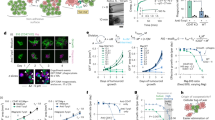Abstract
Mast cells were shown to accumulate around the periphery of the invasive and metastatic rat mammary adenocarcinoma (MTLn3), and histological evidence of mast cell degranulation was observed during the later stages of this model. To assess the physiological role of mast cells in vivo we have used the mast cell-stabilising compound FPL 55618 applied i.p. daily at 1 mg kg-1 for 23 days. Using groups of 12 rats we have found that this compound inhibited tumour growth at the primary site by as much as 70% in most of the treated animals compared with the control group which received equivalent volumes of saline. When the drug treatment was stopped after 23 days, tumour growth of the test group accelerated over the next 7 days and reached a similar tumour size to that of control animals. Histological studies of the tumour and contiguous host tissue at day 24 of the experiment revealed numerous extra-tumoural mast cells often showing signs of degranulation at several sites around the tumour periphery in the control animals. Such observations were not seen in those animals receiving FPL 55618 where, in contrast to controls, numerous intact mast cells were often seen within the tumour mass. Following cessation of the MC-stabilising treatment progressive mast cell activation was evident within 2-4 days, primarily at the tumour periphery. In vitro studies have shown that drug concentrations equivalent to five times the in vivo dose had no effect on the proliferative rate or viability of the MTLn3 cells. Moreover, the proliferative rate of these cells in culture was significantly increased when exposed to soluble mast cell products. Thus our data indicate that a mast cell-stabilising compound has significant benefits in reducing tumour growth in vivo, an observation which supports the concept that mast cell:tumour cell interactions are important for the growth and invasive properties demonstrated by this model of breast carcinoma.
This is a preview of subscription content, access via your institution
Access options
Subscribe to this journal
Receive 24 print issues and online access
$259.00 per year
only $10.79 per issue
Buy this article
- Purchase on Springer Link
- Instant access to full article PDF
Prices may be subject to local taxes which are calculated during checkout
Similar content being viewed by others
Author information
Authors and Affiliations
Rights and permissions
About this article
Cite this article
Dabbous, M., Haney, L., Nicolson, G. et al. Mast cell modulation of tumour cell proliferation in rat mammary adenocarcinoma 13762NF. Br J Cancer 63, 873–878 (1991). https://doi.org/10.1038/bjc.1991.192
Issue Date:
DOI: https://doi.org/10.1038/bjc.1991.192
This article is cited by
-
Tumor microenvironment: a main actor in the metastasis process
Clinical & Experimental Metastasis (2012)
-
Biomarkers of metastatic potential in cultured adenocarcinoma clones
Clinical & Experimental Metastasis (2011)
-
Mast cell: insight into remodeling a tumor microenvironment
Cancer and Metastasis Reviews (2011)
-
Canine Transmissible Venereal Tumour: Asessment of Mast Cell Numbers as Indicators of the Growth Phase
Veterinary Research Communications (2006)
-
The contributions of Santiago Ramón y Cajal to cancer research — 100 years on
Nature Reviews Cancer (2005)



